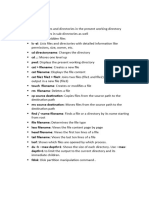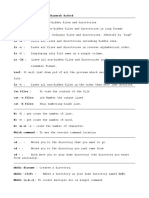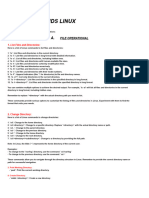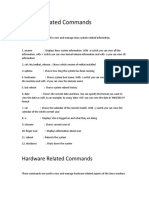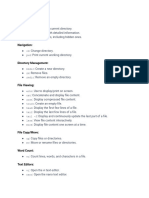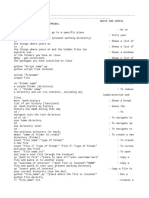0 ratings0% found this document useful (0 votes)
29 viewsImportant Linux Commands
This document lists and describes 43 common Linux commands, including their basic functions and most common arguments. The commands covered include file management commands like ls, cd, and cp; process management commands like ps, kill, and top; networking commands like ping, ifconfig, and route; user and permission management commands like passwd, useradd, and sudo; and system utilities like hostname, journalctl, and systemctl.
Uploaded by
mostafa omarCopyright
© © All Rights Reserved
Available Formats
Download as PDF, TXT or read online on Scribd
0 ratings0% found this document useful (0 votes)
29 viewsImportant Linux Commands
This document lists and describes 43 common Linux commands, including their basic functions and most common arguments. The commands covered include file management commands like ls, cd, and cp; process management commands like ps, kill, and top; networking commands like ping, ifconfig, and route; user and permission management commands like passwd, useradd, and sudo; and system utilities like hostname, journalctl, and systemctl.
Uploaded by
mostafa omarCopyright
© © All Rights Reserved
Available Formats
Download as PDF, TXT or read online on Scribd
You are on page 1/ 5
Linux Commands
There are some basic Linux commands with
their arguments and functions:
1. `ls`: List directory contents
- `-a`: List all files, including hidden files.
- `-l`: Use a long listing format that includes file
permissions, ownership, size, and modification date.
- `-h`: Use human-readable file sizes.
2. `cd`: Change directory
- `<directory>`: Change to the specified directory.
- `~`: Change to the home directory.
- `-`: Change to the previous directory.
3. `pwd`: Print working directory
- No arguments.
4. `mkdir`: Make directory
- `<directory>`: Create a directory with the specified name.
- `-p`: Create parent directories if they don't exist.
5. `rmdir`: Remove directory
- `<directory>`: Remove the specified directory.
- `-p`: Remove parent directories if they are empty.
6. `cp`: Copy files or directories
- `<source>` `<destination>`: Copy the source file or directory
to the destination.
- `-r`: Copy directories recursively.
- `-i`: Prompt before overwriting existing files.
7. `mv`: Move or rename files or directories
- `<source>` `<destination>`: Move the source file or directory
to the destination.
- `-i`: Prompt before overwriting existing files.
8. `rm`: Remove files or directories
- `<file>`: Remove the specified file.
- `-r`: Remove directories and their contents recursively.
- `-f`: Force removal without prompting.
9. `cat`: Concatenate and print files
- `<file>`: Display the contents of the specified file.
- `-n`: Number the output lines.
10. `less`: Display file contents page by page
- `<file>`: Display the contents of the specified file.
- `SPACE`: Scroll forward one screen.
- `b`: Scroll backward one screen.
11. `head`: Display first lines of a file
- `<file>`: Display the first 10 lines of the specified file.
- `-n`: Specify the number of lines to display.
12. `tail`: Display last lines of a file
- `<file>`: Display the last 10 lines of the specified file.
- `-n`: Specify the number of lines to display.
- `-f`: Output appended data as the file grows.
13. `grep`: Search file for lines matching a pattern
- `<pattern>` `<file>`: Search for lines that match the
specified pattern in the specified file.
- `-i`: Ignore case when searching.
- `-r`: Search recursively through directories.
14. `find`: Search for files in a directory hierarchy
- `<directory>` `-name <pattern>`: Search for files in the
specified directory that match the specified pattern.
- `-type <type>`: Search for files of the specified type (`f`
for regular files, `d` for directories, `l` for symbolic links).
15. `chmod`: Change file permissions
- `<mode>` `<file>`: Change the permissions of the specified
file to the specified mode (e.g. `chmod 644 file.txt`).
- `-R`: Change permissions recursively for directories and
their contents.
16. `chown`: Change file ownership
- `<user>` `<file>`: Change the owner of the specified file to
the specified user.
- `-R`: Change ownership recursively for directories and their
contents.
17. `ps`: Display information about running processes
- No arguments: Display information about processes owned by
the current user.
- `-e`: Display information about all processes.
- `-f`: Use a full listing format that includes process
details.
18. `kill`: Send a signal to a process
- `<pid>`: Send the default signal (`SIGTERM`) to the process
with the specified process ID.
- `-s <signal>` `<pid>`: Send the specified signal to the
process with the specified process ID.
19. `top`: Display system resource usage and processes
- No arguments: Display resource usage and process information
in real time.
- `-u <user>`: Display resource usage and process information
for the specified user.
- `-p <pid>`: Display resource usage and process information
for the specified process ID.
20. `df`: Display disk space usage
- No arguments: Display disk space usage for all mounted file
systems.
- `-h`: Use human-readable file sizes.
- `-T`: Display file system type.
21. `du`: Display disk usage of files and directories
- `<file or directory>`: Display disk usage of the specified
file or directory.
- `-h`: Use human-readable file sizes.
- `-s`: Display summary only.
22. `tar`: Manipulate archive files
- `c`: Create a new archive file.
- `x`: Extract files from an archive file.
- `t`: List the contents of an archive file.
- `f`: Use the specified file as the archive file.
- `z`: Compress or decompress files using gzip.
- `j`: Compress or decompress files using bzip2.
23. `gzip`: Compress files using the gzip algorithm
- `<file>`: Compress the specified file.
- `-d`: Decompress the specified file.
- `-k`: Keep the original file after compressing or
decompressing.
24. `gunzip`: Decompress files compressed with gzip
- `<file>`: Decompress the specified file.
- `-k`: Keep the original file after decompressing.
25. `ssh`: Connect to a remote host over SSH
- `<user>@<host>`: Connect to the specified host as the
specified user.
- `-p <port>`: Use the specified port for the SSH connection.
26. `scp`: Copy files between hosts over SSH
- `<source>` `<destination>`: Copy the source file or
directory to the destination over SSH.
- `-r`: Copy directories recursively.
- `-P <port>`: Use the specified port for the SSH connection.
27. `rsync`: Copy files between hosts efficiently
- `<source>` `<destination>`: Copy the source file or
directory to the destination.
- `-r`: Copy directories recursively.
- `-a`: Preserve file permissions and ownership.
- `-v`: Verbose output.
28. `ping`: Test network connectivity to a host
- `<host>`: Test network connectivity to the specified host.
- `-c <count>`: Send the specified number of packets.
- `-i <interval>`: Wait the specified number of seconds
between packets.
29. `ifconfig`: Configure network interfaces
- No arguments: Display network interface configuration.
- `<interface>` `<address>`: Configure the specified network
interface with the specified IP address.
- `up`: Enable the specified network interface.
30. `route`: Display or modify the routing table
- No arguments: Display the routing table.
- `add <network> gw <gateway>`: Add a route to the specified
network via the specified gateway.
- `del <network>`: Delete the route to the specified network.
31. `netstat`: Display network connections and statistics
- No arguments: Display active network connections.
- `-a`: Display all network connections, including listening
sockets.
- `-r`: Display the routing table.
32. `iptables`: Configure firewall rules
- `<chain>` `<rule>`: Add a rule to the specified chain (e.g.
`iptables INPUT -p tcp --dport 22 -j ACCEPT`).
- `-L`: List the current firewall rules.
- `-F`: Flush all firewall rules.
33. `systemctl`: Control the systemd system and service manager
- `start <service>`: Start the specified service.
- `stop <service>`: Stop the specified service.
- `restart <service>`: Restart the specified service.
- `status <service>`: Display the status of the specified
service.
34. `journalctl`: Query the systemd journal
- No arguments: Display all log messages in the journal.
- `-u <unit>`: Display log messages for the specified systemd
unit.
- `-f`: Follow the journal in real time.
35. `passwd`: Change user password
- No arguments: Change the password for the current user.
- `<user>`: Change the password for the specified user.
36. `useradd`: Add a new user account
- `<user>`: Create a new user account with the specified
username.
- `-m`: Create a home directory for the new user.
37. `userdel`: Delete a user account
- `<user>`: Delete the specified user account.
- `-r`: Remove the user's home directory and mail spool.
38. `groupadd`: Add a new group
- `<group>`: Create a new group with the specified name.
39. `groupdel`: Delete a group
- `<group>`: Delete the specified group.
40. `sudo`: Execute a command with superuser privileges
- `<command>`: Execute the specified command with superuser
privileges.
- `-u <user>`: Execute the command as the specified user.
41. `su`: Switch to another user account
- `<user>`: Switch to the specified user account.
- `-`: Switch to the specified user account and its
environment.
42. `whoami`: Display current user name
- No arguments.
43. `hostname`: Display or set the system hostname
- No arguments: Display the current hostname
You might also like
- 50 Linux Commands That Are Very Useful For DevOps TasksNo ratings yet50 Linux Commands That Are Very Useful For DevOps Tasks10 pages
- Essential Linux Command For Devops Engineer Docx 20231105 002106No ratings yetEssential Linux Command For Devops Engineer Docx 20231105 0021065 pages
- SAP Customer Activity Repository 4.0 FPS01: WarningNo ratings yetSAP Customer Activity Repository 4.0 FPS01: Warning34 pages
- WinZO Is India's Largest Vernacular Social Gaming Platform.No ratings yetWinZO Is India's Largest Vernacular Social Gaming Platform.3 pages
- Manoj Regmi Intern Report For Mid DefenceNo ratings yetManoj Regmi Intern Report For Mid Defence27 pages
- Controller Tool Help: Code No. LIT-12011147 Software Release 10.2 Issued December 2015No ratings yetController Tool Help: Code No. LIT-12011147 Software Release 10.2 Issued December 20151,528 pages
- Chem200 Service Manual 2-32 - 240209 - 091706No ratings yetChem200 Service Manual 2-32 - 240209 - 091706159 pages
- Lpi Selftestengine 101-500 PDF 2019-Nov-30 by Peter 166q Vce PDFNo ratings yetLpi Selftestengine 101-500 PDF 2019-Nov-30 by Peter 166q Vce PDF6 pages
- The Use of GIS in Geotechnical EngineeringNo ratings yetThe Use of GIS in Geotechnical Engineering25 pages
- Create Connected Shop With GrabCAD - EN BrochureNo ratings yetCreate Connected Shop With GrabCAD - EN Brochure7 pages
- 50 Linux Commands That Are Very Useful For DevOps Tasks50 Linux Commands That Are Very Useful For DevOps Tasks
- Essential Linux Command For Devops Engineer Docx 20231105 002106Essential Linux Command For Devops Engineer Docx 20231105 002106
- SAP Customer Activity Repository 4.0 FPS01: WarningSAP Customer Activity Repository 4.0 FPS01: Warning
- WinZO Is India's Largest Vernacular Social Gaming Platform.WinZO Is India's Largest Vernacular Social Gaming Platform.
- Controller Tool Help: Code No. LIT-12011147 Software Release 10.2 Issued December 2015Controller Tool Help: Code No. LIT-12011147 Software Release 10.2 Issued December 2015
- Lpi Selftestengine 101-500 PDF 2019-Nov-30 by Peter 166q Vce PDFLpi Selftestengine 101-500 PDF 2019-Nov-30 by Peter 166q Vce PDF










